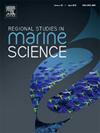Metal(loid) accumulation and ecotoxicological assessment in cartilaginous fishes from the Northeastern Mediterranean
IF 2.4
4区 环境科学与生态学
Q3 ECOLOGY
引用次数: 0
Abstract
The present study was conducted with the objective of ascertaining the levels of selected metal(loid)s in the muscle, liver, spleen, kidney, stomach, intestinal, and gonad tissues of seven distinct cartilaginous species sampled from Northern Cyprus. This initiative was undertaken to address the dearth of metal bioaccumulation data for cartilaginous species and to elucidate the impact of metal pollution on these species, which are distinguished by their limited reproductive capacity. The samples were obtained from discarded species captured during commercial fishing activities. The metal concentrations in these tissues were subsequently determined using Inductively Coupled Plasma Mass Spectrophotometry (ICP-MS). The results indicated that the kidney tissue of Squalus blainville exhibited the highest concentrations of Al, Cr, and Pb, while Raja clavata showed the highest concentrations of Mn and Sr in the kidney and muscle tissues. Furthermore, Chimaera monstrosa demonstrated the highest concentrations of Fe in the liver, while Dipturus oxyrinchus exhibited the highest concentrations of Zn, As, and Cd in the kidney tissue. The observation that As and Fe exhibited the highest tissue concentrations among the metal(loid)s analysed in all species suggests that As pollution levels in the Northeastern Mediterranean region may be particularly high.
地中海东北部软骨鱼类的金属(样物质)积累及生态毒理学评价
本研究的目的是确定从北塞浦路斯采集的七种不同软骨物种的肌肉、肝脏、脾脏、肾脏、胃、肠道和性腺组织中选定的金属(样蛋白)的水平。这项倡议是为了解决软骨物种金属生物积累数据的缺乏问题,并阐明金属污染对这些物种的影响,这些物种的特点是繁殖能力有限。样本来自商业捕鱼活动中捕获的废弃鱼种。随后使用电感耦合等离子体质分光光度法(ICP-MS)测定这些组织中的金属浓度。结果表明,白角鲨肾脏组织中Al、Cr、Pb含量最高,而拉贾鼠肾脏和肌肉组织中Mn、Sr含量最高。此外,中国巨兽肝脏中铁含量最高,而虎尾龙肾脏组织中锌、砷和镉含量最高。观察到砷和铁在所有物种分析的金属(样物质)中表现出最高的组织浓度,这表明地中海东北部地区的砷污染水平可能特别高。
本文章由计算机程序翻译,如有差异,请以英文原文为准。
求助全文
约1分钟内获得全文
求助全文
来源期刊

Regional Studies in Marine Science
Agricultural and Biological Sciences-Ecology, Evolution, Behavior and Systematics
CiteScore
3.90
自引率
4.80%
发文量
336
审稿时长
69 days
期刊介绍:
REGIONAL STUDIES IN MARINE SCIENCE will publish scientifically sound papers on regional aspects of maritime and marine resources in estuaries, coastal zones, continental shelf, the seas and oceans.
 求助内容:
求助内容: 应助结果提醒方式:
应助结果提醒方式:


